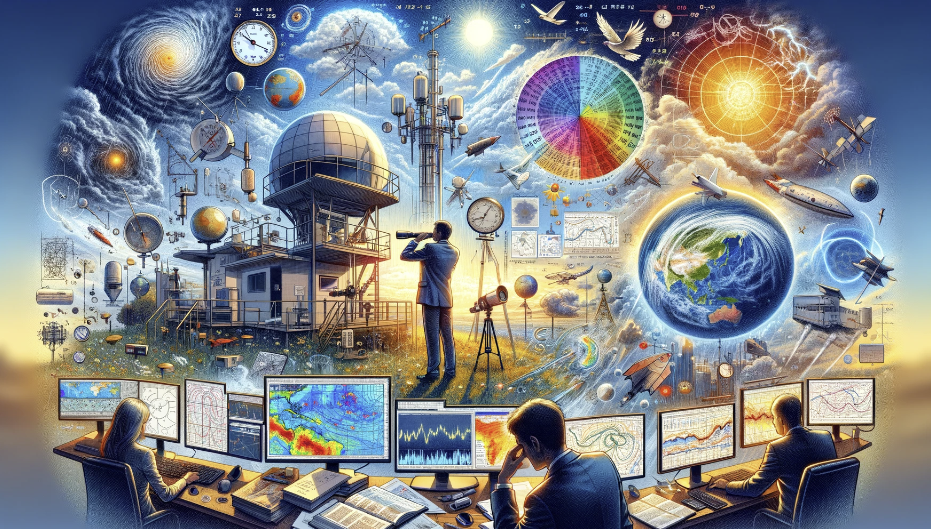Introduction: Weather forecasting is the role of a lot of operational meteorologists. In Part 10, we’ll explore the fascinating world of weather forecasting, including the tools, techniques, and models meteorologists use to predict the ever-changing conditions of our atmosphere. We’ll also conclude our journey through the world of meteorology.
The Science of Weather Forecasting: Weather forecasting is both an art and a science. It involves analyzing data from various sources, understanding atmospheric processes, and using computer models to make predictions about future weather conditions. It also includes a bit of blending the real data with personal experience. And that blend is often why a weather forecast from one outlet may not match another outlet.
Here are some key aspects of weather forecasting:
- Data Collection: Meteorologists collect data from a vast array of sources, including weather stations, satellites, radar systems, weather balloons, and buoys. These data provide a snapshot of the current state of the atmosphere.
- Numerical Weather Models: Meteorologists use powerful computers to run numerical weather models that simulate the behavior of the atmosphere. These models take into account factors like temperature, pressure, humidity, and wind patterns to predict future weather conditions.
- Weather Charts and Maps: Meteorologists create weather charts and maps that display data and model outputs in a visual format. These charts help them identify weather patterns and make forecasts.
- Observations: Observations from weather instruments and observations by trained meteorologists in the field play a crucial role in verifying and refining forecasts.

Challenges in Weather Forecasting: Weather forecasting is inherently challenging due to the complex and chaotic nature of the atmosphere. Some of the challenges meteorologists face include:
- Uncertainty: Weather systems can change rapidly, leading to uncertainties in forecasting. Small errors in initial data can magnify over time, affecting the accuracy of predictions. This is one reason why weather forecasts can change.
- Limited Data: Some regions, such as oceans and remote areas, have limited data coverage, making it challenging to produce accurate forecasts in these areas.
- Extreme Weather Events: Severe weather events like hurricanes and tornadoes are particularly challenging to predict due to their complex dynamics.
The Role of Meteorologists: Meteorologists play a crucial role in interpreting data, monitoring weather patterns, issuing forecasts and warnings, and communicating weather information to the public. Their expertise is invaluable in helping communities prepare for and respond to changing weather conditions.
There are a handful of types of meteorologists most people are familiar:
- Television meteorologist: Television meteorologists are experts in weather forecasting who deliver weather information to the public through television broadcasts. They use maps, graphics, and their communication skills to provide viewers with accurate and easily understandable weather updates.
- National Weather Service Meteorologist: National Weather Service meteorologists work for the government agency responsible for weather forecasting and monitoring in the United States. They use advanced technology and data to issue weather warnings and forecasts for the safety and well-being of the public.
- Private Enterprise Meteorologist: Private enterprise meteorologists are employed by companies, such as consulting firms or weather-focused businesses, to provide weather-related services, forecasts, and insights to various industries like agriculture, insurance, and retail, helping them make informed decisions and mitigate weather-related risks.
- Aviation Meteorologist: Aviation meteorologists specialize in providing weather information and forecasts tailored to the aviation industry. They ensure safe and efficient air travel by offering insights into weather conditions that can impact flight routes, takeoffs, and landings.
- Energy Sector Meteorologist: Energy sector meteorologists work in the energy industry, including sectors like renewable energy, oil and gas, and utilities. They use weather data to optimize energy production, distribution, and consumption, helping companies manage resources and respond to weather-related challenges efficiently.

Take Home: Our journey through the world of meteorology has provided insights into the intricate workings of the Earth’s atmosphere. We’ve explored meteorological concepts, from the basics of temperature and humidity to the formation of clouds, air masses, fronts, and weather systems. We’ve also delved into the art and science of weather forecasting.
Weather impacts every aspect of our lives, influencing our daily routines, safety, agriculture, transportation, and more. By gaining a deeper understanding of meteorology, we can make informed decisions, stay prepared for changing weather, and appreciate the marvels of the natural world.
We hope the first part of this weather education series has been informative and engaging, inspiring your curiosity about the atmosphere that surrounds us. If you have further questions or topics you’d like us to explore, please feel free to reach out. Stay curious, stay weather-aware, and stay tuned for more exciting journeys into the world of science and nature.
Thank you for joining us on this meteorological adventure! We will have even more posts in the coming days!

